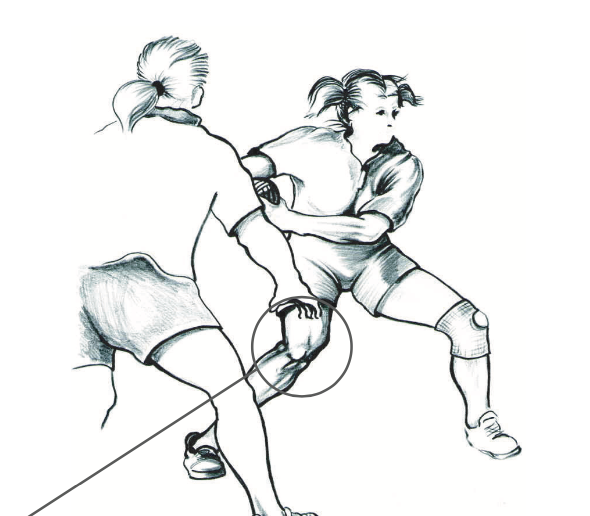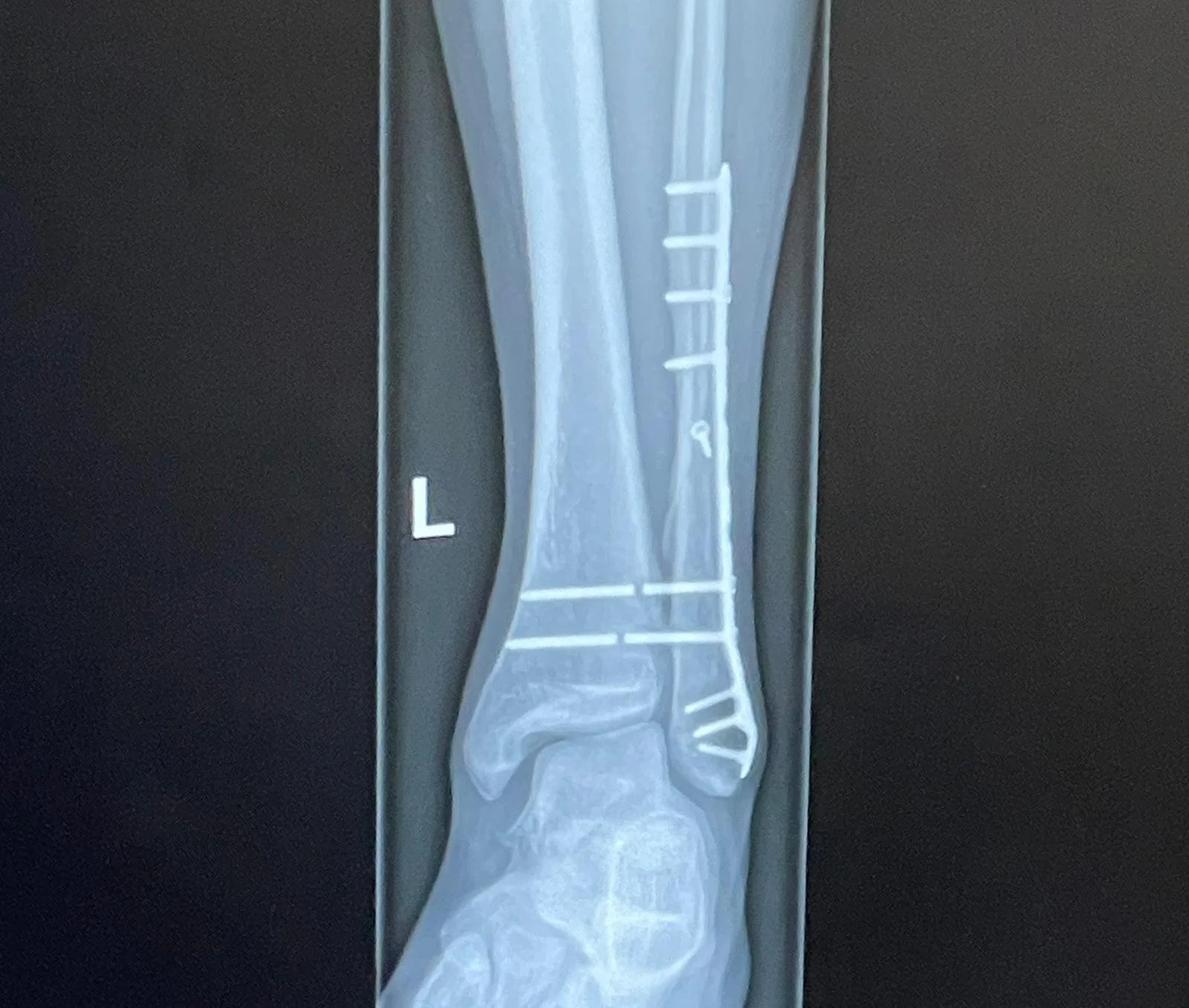Jumper's Knee (Patellar Tendinopathy)
A common knee injury that Physiotherapists treat, Patellar Tendinopathy, also known as Jumper’s knee, is pain located at the front of your knee, under your knee cap.
It is a specific injury to the Tendon connecting your Patella (Knee Cap) to your Tibia (Shin bone).
Tendinopathies (read about them here), are a complex category of sports injuries that could potentially have lengthy recovery times, especially when they’re not optimally managed.
There are some general principles that apply to the Physiotherapy treatment of Tendinopathies in general, but we’ll take a more detailed look at the specifics of Patellar Tendinopathy.
JUMPER'S KNEE SYMPTOMS
The common aggravating factor that is consistent across all tendinopathies, is pain with increased loading.
Here are some common activities that will typically aggravate Patellar Tendon pain:
Jumping
Landing
Running
Squatting and Lunging
Did you know that the patellar tendon can be aggravated even with seemingly simple activities of daily living? Here are the most common activities that you may notice aggravate your Jumper’s Knee
Sitting for a long period of time (static positions minimise circulation, swelling persists in the tendon)
Kneeling on your knees (increased compression on the tendon)
Walking downstairs (increased loading when you step down)
In addition to these common symptoms, many clients with Jumper’s Knee will report that when they first start their run (or exercise), the knee is quite painful, but after ‘warming it up’, then the pain reduces and they can continue their run. However, after their run, the pain eventually returns!
CAUSES OF JUMPER’S KNEE
Each individual will have their own unique factors that contributed to the development of their injury, but we’ll outline the main, common causes!
1: SUDDEN INCREASE IN KNEE DOMINANT LOADING
This describes an acute overload in how much force the Patellar Tendon is being tasked to deal with.
Too much Too soon.
In reality, this could look like someone going on a health kick, picking up running at the start of the year when they previously hadn’t run in the past few years.
Or someone returning to play volleyball after a long off season. All the intense jumping and landing places extreme load on the patellar tendon, leading to an injury.
This is the most common mechanism that we notice amongst our clients with Patellar Tendinopathy.
2: POOR BIOMECHANICS
When we treat athletes, we look at their athletic movement as a highly skilled and coordinated sequence of movements across different joints and muscles to play their sport.
We have to look at the entirety of how their body moves as a whole and identify any of the moving parts that are potentially dysfunctional or sub-optimal.
These dysfunctional parts usually lead to overcompensation of load elsewhere - commonly being the knee and patellar tendon.
Let’s look at a basketball player as an example, who is landing after jumping up for a rebound.
When we assess his/her jumping and landing, we may see that there is a lack of core stability and control, which could look like him flexing excessively or leaning more to one side as they land.
Over time, this could gradually place more load on one knee than it is capable of, and may eventually lead to the development of jumper’s knee.
The way we would address this issue is to implement isolated core work initially, and gradually progress that practising proper landing mechanics where they’re able to load each leg evenly, and maintain a more neutral spine.
The same principle can be applied if the Physiotherapist or Coach notices dynamic valgus in the knees which would suggest a lack of dynamic stability in the hips/pelvis which is typically provided by the gluteal muscle group.
An in-depth analysis of your athletic movement is essential to determine what your movement looks like and where it could be optimised to address the cause of your injury.
Our team at Physiologic have years of experience working with elite athletes to identify the cause of their injuries, and to prescribe effective rehabilitation protocols that get them out of pain, fixing their injury for good. Contact us to find out how we can help you get back to your competitive best!
Knee valgus (caving in) as a risk factor for knee pain.
3: PREVIOUS INJURIES
Previous injuries are a common factor to the development of Jumper’s knee, and in particular, foot and ankle injuries.
Previous ankle sprains and fractures are usual culprits, as they typically result in either reduced ankle mobility and proprioception, which naturally forces the knee to take on more of the load absorbing duties in dynamic tasks.
This excessive force on the knee, coupled with a recent health kick and regular running could be a recipe for the development of Jumper’s Knee.
Previous Ankle fracture as a risk factor for developing Jumpers Knee
PHYSIOTHERAPY TREATMENT OF PATELLAR TENDINOPATHY
1: TEMPORARY PERIOD OF REDUCED LOADING
As a general principle, we will usually recommend a temporary period of reduced activity (NOT COMPLETE REST), to allow the pain to settle and avoid continuous aggravation.
This is important to break the vicious cycle of doing too much, causing more damage, having more pain and so on.
Note how we did not recommend complete rest, this is important.
If you go back to our initial blog on Tendinopathies (here), one of the most effective ways to rehabilitate a tendon effectively is to LOAD IT!
This means that your Physiotherapist will advise you on what you CAN still do, while you’re recovering from your Patellar Tendinopathy.
Commonly, this may be advice to avoid dynamic exercises like jumping/running/sports, but strength exercises in the gym like squats/step ups, knee extensions may still be appropriate.
Here’s a common exercise called the step up that I like to use to maintain some safe loading patterns in the knee, while maintaining the activation and control of key muscles needed for athletic performance.
2: ISOMETRICS FOR PAIN RELIEF
Isometrics are a useful tool that has been proven to be a powerful pain relieving exercise in people with tendinopathies.
They are also an excellent rehab exercise that starts to encourage some collagen fibre realignment and replenishment in the injured tendon.
Here’s how we perform Spanish Squats to help with Patellar Tendinopathies.
3: ADDRESSING DYSFUNCTIONAL BODY PARTS
As mentioned earlier, dysfunctional joints as a result of previous injuries or poor movement patterns can be contributing to the overload of your Patellar Tendon.
So part of the rehabilitation program must address these weak links - if not, your pain is likely to come back again!
A common part to look at is ANKLE DORSIFLEXION!
Here’s a banded mobility drill you can do to help improve your ankles mobility.
4: SHOCKWAVE THERAPY
We briefly mentioned shockwave therapy in the tendinopathy blog, and we generally reserve this treatment modality for more chronic cases.
It is an uncomfortable procedure, but has been proven to be effective in encouraging better recovery in Chronic tendon injuries.
At Physiologic, we have a state of the art PiezoWave Shockwave machine that we commonly use with our clients dealing with Chronic Tendinopathies, Contact Us to see if it’s something that could potentially help with your injury!
5: RETURN TO ACTIVITY/SPORT LOAD MANAGEMENT
The most important aspect for the treatment and prevention of re-injury, is for the Physiotherapist to guide the client safely on their return to activity or sport.
The Physiotherapist is responsible for monitoring, adjusting and guiding the client through gradually increasing activity as their body allows.
Too much activity too soon and you’ll be back at square one.
Not enough activity and you may not reach your ultimate goals!
Speak with one of our expert Physiotherapists experienced in providing complete injury solutions for the management of Patellar Tendinopathies.
CONCLUSION
The best solutions for overcoming Jumpers Knee starts with a detailed assessment to identify ALL your unique contributing factors.
Then comes the hard work, adhering to the guidelines your Physiotherapist has set out for you, and being consistent with the rehabilitation program.
If you’re dealing with Jumper’s Knee, get in touch with us to see how we can help get you out of pain, and back performing at your best!
About the Author
Ryan Tan is our Clinical Director and Physiotherapist here at Physiologic Hong Kong. He’s had over 10 years of experience as a sports and musculoskeletal Physiotherapist, having looked after elite athletes such as the NZ Rugby 7’s team and more recently, some of Hong Kong’s top Trail Runners. He attributes his client’s successes to their commitment in being diligent with his individual rehabilitation programs, and curated treatment protocols for each individual. Excellent relationships with some of Hong Kong’s top Orthopaedic Surgeons also allows Ryan to provide a truly multidisciplinary team approach to his clients health care. Contact us to speak with Ryan if you are looking for an experienced Physiotherapist to guide you back to your competitive best!



